
West coast
Negombo is a beach town popular mainly due to its proximity to the Bandaranaike International Airport (it’s actually closer and easier to get to from the airport than Colombo).
I only spent an afternoon there, but it was enough to notice that Negombo’s beach is not exactly pristine, and even though there are a few beach restaurants and bars around, frankly speaking I can’t imagine throwing a towel on the sand and sunbathing in Negombo, or going swimming here.

Negombo
At one end of the beach there’s a bunch of fishing boats and fishermen, and when I was taking some photos, I had a first chance of experiencing the friendliness and chatty disposition of the people of Sri Lanka.
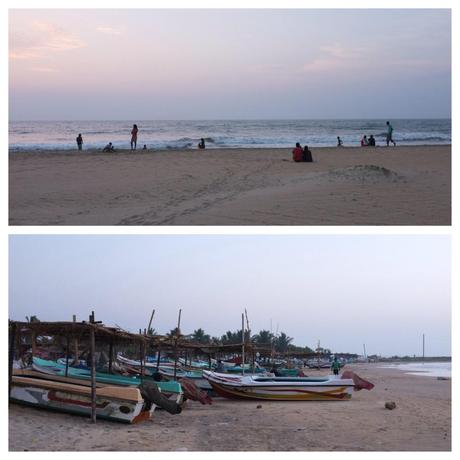
Negombo
There were also a lot of locals on the beach, sitting in front of their houses while their kids were running around and voluntarily posing for photos.
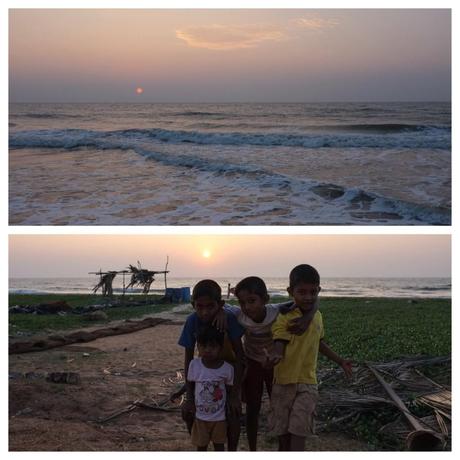
Negombo
The ‘proper’ beach resorts on the west coast are Bentota and Hikkaduwa, both located south of Colombo. Bentota is more upmarket, while Hikkaduwa has a reputation of a destination for the party-oriented young travellers looking for a lively place with a lot going on. I skipped both towns, aiming straight for the southern beaches, but further along my travells I heard several stories about the ‘beach boys’ of Hikkaduwa, who pray on foreign female tourists by serving them date rape drugs in their drinks. Even though I don’t take drinks from strangers, especially if I haven’t seen how they’ve been prepared, I’m still glad I haven’t gone to Hikka.
South coast
My next destination was Unawatuna. I got their by train, first hopping on a local, 3rd class only (if even that) train from Negombo to Colombo, where I was the only foreigner and quite a sensation among the locals (apparently everyone else gets either private transport or a bus on that route), and then taking a long-distance, Matara-bound train from Colombo, which goes along the coast. Seeing the sea throughout the journey made up for having to stand for most of the way (the train was already pretty full when it arrived at Colombo Fort, and then the crowd of people waiting on the platform and hunting for the last available seats made it a lost battle for me and my backpack). Towards the end of the journey a young boy gave me a heads up that he’d be getting off at the next station, so I thankfully took his seat (and my backpack on my lap), tired of being pushed around by the vendors selling all sorts of snacks, hopping in and out at every stop.
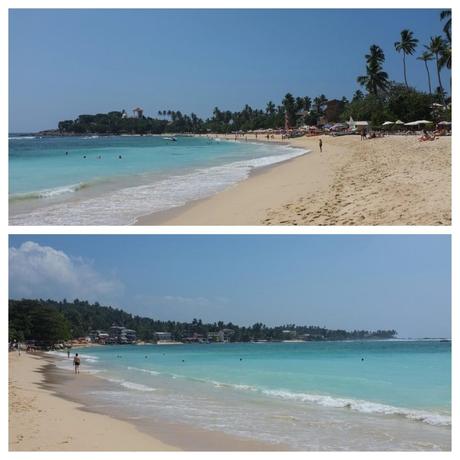
Unawatuna
Unawatuna seems to be extremely popular with Russians (I’d say around 80% of the foreigners I saw there were Russians or Russian speakers), mainly independent travellers, with the majority in their 30s and 40s, but there are also other Europeans, some families (thankfully there aren’t a lot of small kids, though), and some young couples.
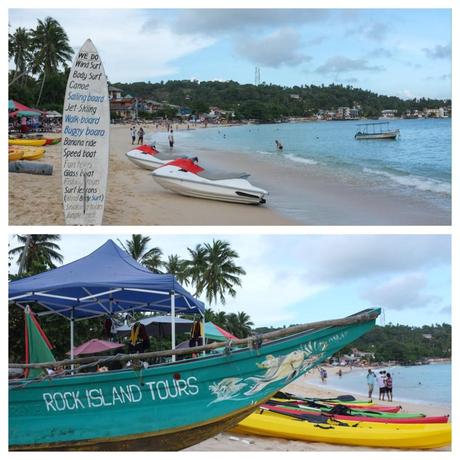
Unawatuna
The beach is rather narrow in places (the owners didn’t learn their lesson after the 2004 tsunami and rebuilt the restaurants and guest houses right by the water), but the sand is white and the sea tourquoise and perfectly calm (which is what I’m always looking for). It does feel rather busy though (January is high season), and sometimes feels somewhat like the beach in Barcelona, only that instead of the Pakistanis offering “cerveza, beer, water, agua, Coca-Cola” and the Chinese ladies offering massage (sounding more like “masachi” to me), here you’ll have locals offering coconuts, mango, pineapples, saris, and yes, massages as well. Oh, and as anywhere in Sri Lanka, you’ll see little piles of trash here and there.
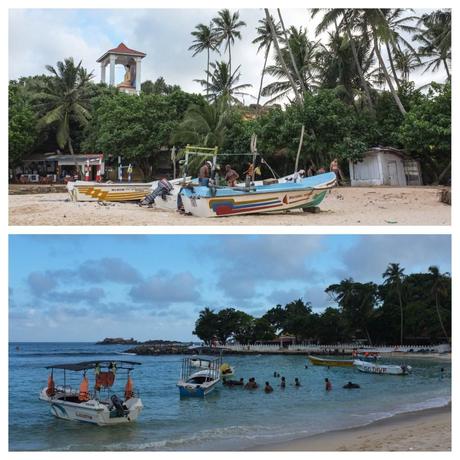
Unawatuna
Accommodation prices are rather steep (for this part of the world), especially near the beach, but they are not set in stone, so you can always bring them down a little, especially if you’re staying for a few nights. Make sure you get a mosquito net with no holes in it, though, and if you’re not a fan of insects, perhaps don’t go for a cabana (the mistake I made for the first two nights).
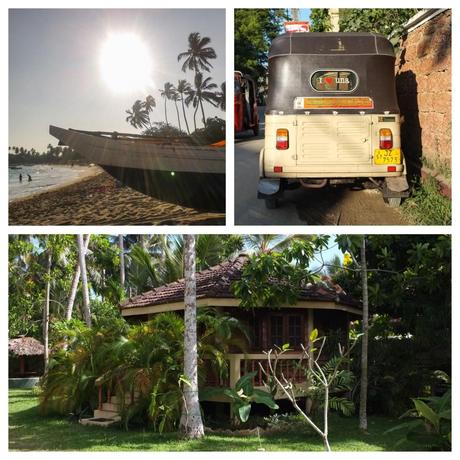
Unawatuna
As for food, there’s something for every pocket. Typically, the restaurants located along the beach will be the most expensive (especially if you opt for seafood), but they can be quite appealing at night, when the tables are set right on the sand and lit up by candles, and there is music playing (ranging from reggae through chillout to the likes of Backstreet Boys, but romantic tunes tend to be a favorite in Asia in general). The more local places along the road have very reasonable food and prices, plus there are a few very cheap roti places, and as a bonus at least two vegetarian / vegan restaurants, offering a variety of quite sophisticated dishes at reasonable prices (both places are run by foreigners, if I’m not mistaken). Finally, you can go for a home-cooked meal, prepared by one of the local families, but those have to be ordered 2 to 3 hours in advance.
A few days later I hopped on a local bus and got off in Mirissa, which is another well-known beach destination in the south. More relaxed and low-key than Unawatuna, it attracts mainly young idependent travellers.

Mirissa
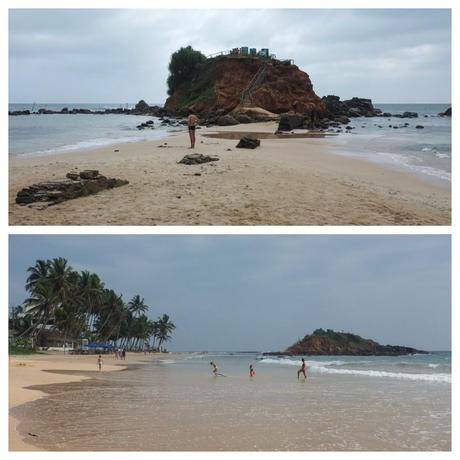
Mirissa

Kalkudah
Even though some guidebooks picture it as more affordable than Unawatuna, I found that accommodation near the beach, as well as some places located more in-land, are priced very similarly to Una, and quite often the standard is even lower (I feel like accommodation standards in Sri Lanka in general have some room for improvement). The further away you get from the beach, the more likely you are to get a better deal, and there seem to be more options here in general, as Mirissa is silghtly bigger than Una.
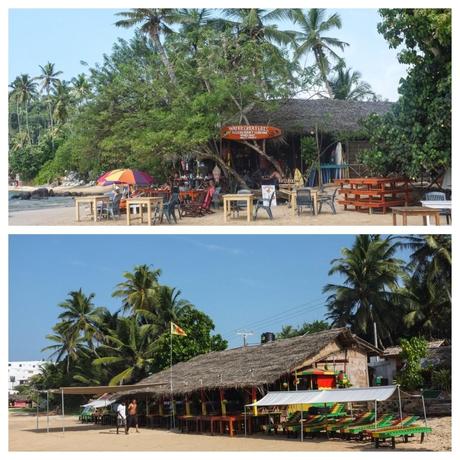
Mirissa
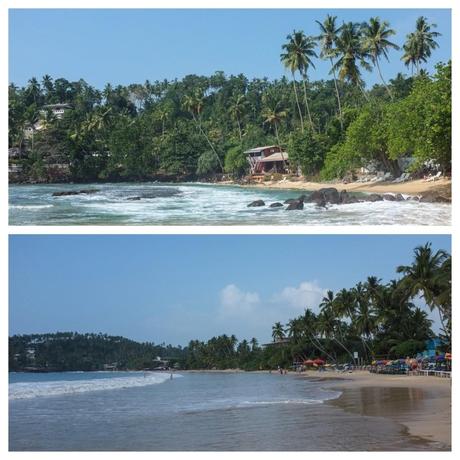
Mirissa
The beach is long and composed of a few little bays marked by small rocks.The sea conditions vary depending on which stretch you’re on, with the waves on both ends of the beach being the biggest, hence there are lots of surfers and surf schools around. There is a little bay where the waves are very small, but for the most part prepare for having to jump through, or dive under, the waves in order to get through to the calmer waters and be able to swim. Unawatuna wins for me hands down for swimming conditions (but for everything apart from swimming I prefer Mirissa).
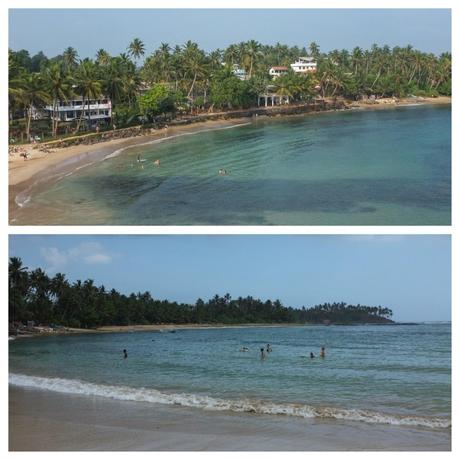
Mirissa
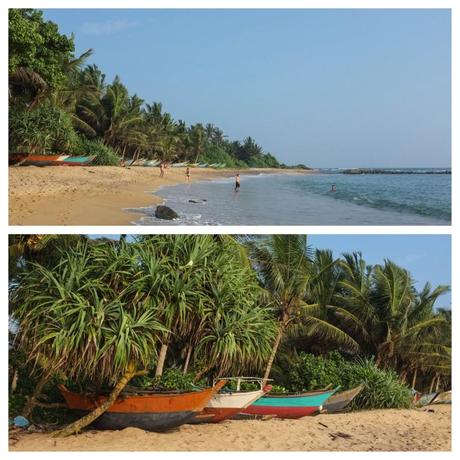
Mirissa
Mirissa also happens to be a leading whale-watching spot in Sri Lanka, but I didn’t sign up for it. As for snorkelling, diving or water sports other than surfing, I wouldn’t say Mirissa is the place to go to. Just hang out on the beach during the day, hang out on the beach in the evening (the beach bars and restaurants are lit up at night and are even more charming than the ones in Unawatuna). Last but not least, have a coconut

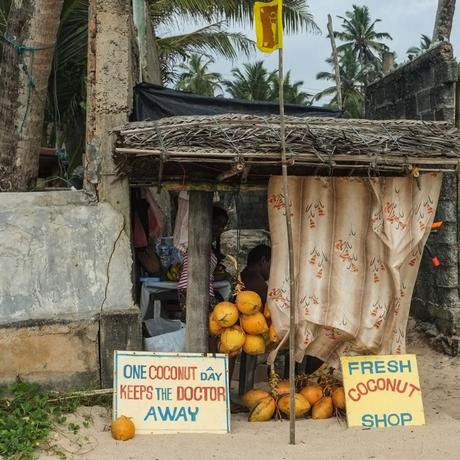
strong marketing :)
Food-wise, there isn’t as much variety here as in Unawatuna, and the food served on the beach tends to be very average (to say the least). Yet I was lucky that the food served at my guest house was excellent (it turned out that they also offered cooking classes), so I didn’t need to look any further.
Since Mirissa doesn’t have a bank, at one point I had to make a trip to a nearby town of Weligama to use an ATM. Weligama is a small fishing town as well as a rather quiet beach resort, known for the stilt fishermen (I saw them from the bus window on my way from Unawatuna to Mirissa, but didn’t manage to find them when I came to Weligama) as well as good conditions for beginning surfers.
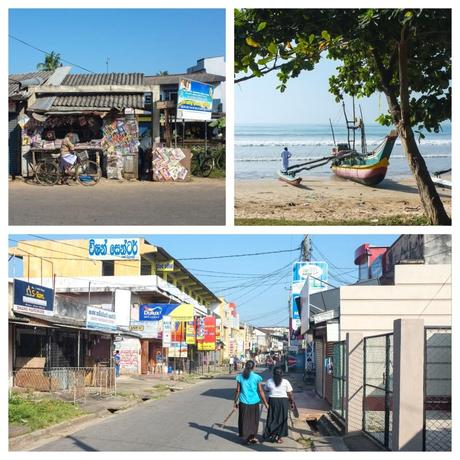
Weligama
East coast
I didn’t plan on going to the east at all, as January is the middle of the monsoon season on this coast, but the locals in Polonnaruwa claimed that the nearby beaches of Passekudah and Kalkudah are perfectly fine at this time. Since I was so close, and since I’m beach-obsessed, I just couldn’t resists. I got there by bus from Polonnaruwa, and then some local friendly souls I met on the way dropped me off at one of the gueshouses located exactly in between the two bays.
Passekudah is the more touristy one out of the two bays, with a few upscale resorts along the beach and lots of new ones springing up. As it was off-season, there weren’t many foreigners to be seen, but one end of the bay was densely populated with local tourists, while the more deserted one was abundant only in sea weed, stray dogs and construction workers.

Passekudah
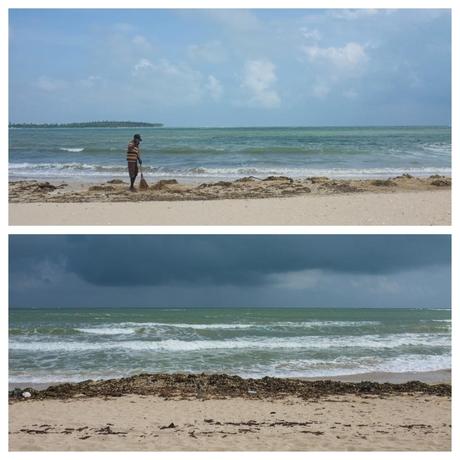
Passekudah
Passekudah’s waters are very shallow, so you could actually get in the water safely despite the waves, but the strong wind and the amount of sea weed present on the beach were an indication that it isn’t quite the season yet, despite the mostly sunny weather. After the monsoon, however, the beach must be spectacular, especially by the Uga Bay hotel, which is amazing.
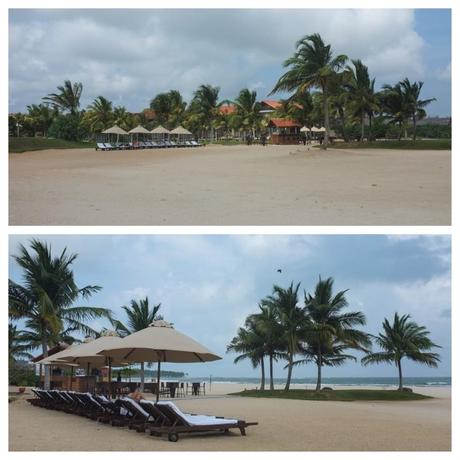
Passekudah
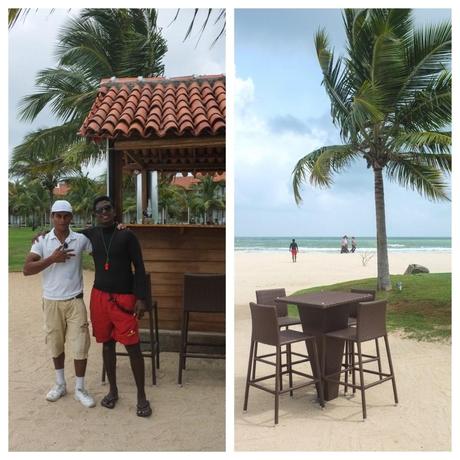
Passekudah
Kalkudah bay on the other hand was almost completely deserted, except for the fishermen on one end of the beach. There are no resort-type hotels there at this point, only a few guest houses, but none of them seemed to be open (but as in Passekudah, some new ones are currently buing built). But for the most part, the beach was deserted, with only fishing boats and fishing nets to be found here and there.
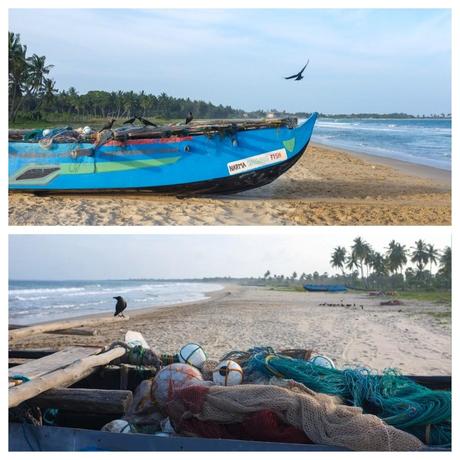
Kalkudah
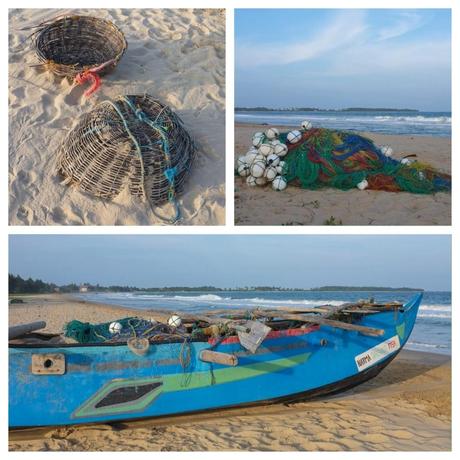
Kalkudah
When I came back to Kalkudah in the morning, there were hardly any dry strips of sand to throw a towel on (it must have been high tide), and the sea was quite rough again. Since the water is much deeper here than in Passekudah, I didn’t dare to get in (the locals actually warned me that it’s dangerous at this time). Another thing was the fact that there was a local or two strolling along the beach every once in a while, which made me feel a bit out of place in my bikini and with no other foreigners around.
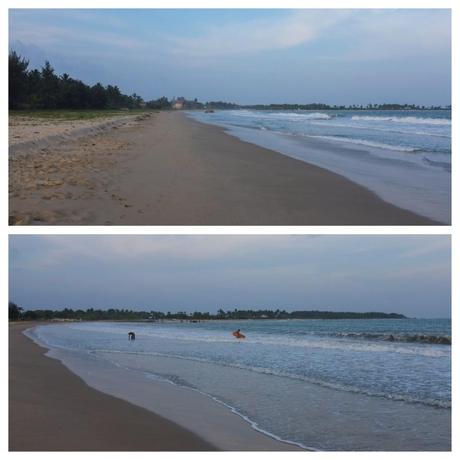
Kalkudah
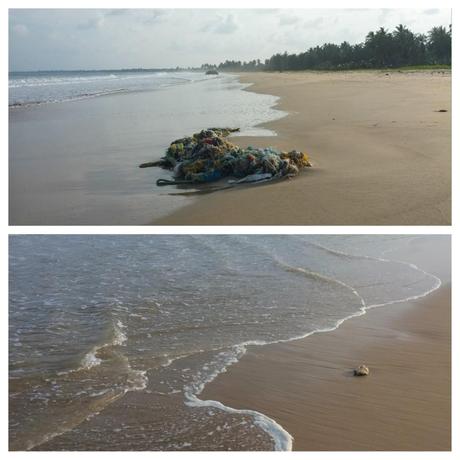
Kalkudah
As for the food, I ate mainly at my guest house (the only alternative would be going to one of the hotels, because there are no independent restaurants in the area), and I ate mainly sea food (prawns, crabs and cuttle fish). The food was very good, and the portions were more than generous.
The last point I have to make about the east coast is its people. Maybe it’s because they’ve suffered a lot (the tsunami in 2004 as well as the civil war, which affected the east quite strongly, and which ended only in 2009), or maybe it’s just my personal experience, but the people in the area seemed extremely kind. Much more so than in, say, Unawatuna, or other typically touristy locations on the island, though it has to be said that the people of Sri Lanka are on the whole very open and friendly. The people in the east might be slightly more shy, but they will give you the loveliest smile if you greet them (in other parts of Sri Lanka it’s the locals who’ll greet you first… and then offer their services as tuk tuk drivers, guest house owners, etc.).
Final thoughts
Though I’m not tempted to explore the west coast in more depth, I’d be interested in coming back to the east coast one day, heading to Trincomalee and maybe Arugam Bay, as well as to Tangalla on the south coast. And if I was to give advice, I’d say skip the west coast and give the south and east coast a shot.

